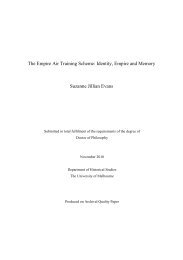Lessons from the Evolution of Western Land Administration Systems
Lessons from the Evolution of Western Land Administration Systems
Lessons from the Evolution of Western Land Administration Systems
Create successful ePaper yourself
Turn your PDF publications into a flip-book with our unique Google optimized e-Paper software.
Lisa Ting, Ian Williamson, Don Grant & John R. Parker:<strong>Lessons</strong> <strong>from</strong> <strong>the</strong> <strong>Evolution</strong> <strong>of</strong> <strong>Western</strong> <strong>Land</strong> <strong>Administration</strong> <strong>Systems</strong>„Australia has, over <strong>the</strong> last few years, made considerable changes to <strong>the</strong>number <strong>of</strong> government services provided and to <strong>the</strong> way <strong>the</strong>y are delivered.Measures have been taken to minimize government intervention and expenditure(capital and recurrent), and make more efficient use <strong>of</strong> public sector resources.Trade practices, competition policies and mutual recognition <strong>of</strong> trades,pr<strong>of</strong>essions and occupations across jurisdictions, have all beenreassessed.“(Lanphier & Parker, 1997)This shift in economic thinking also comes at a time <strong>of</strong> impassioned calls for morecentralized and coordinated global action on <strong>the</strong> environment, as exemplified byAgenda 21, <strong>the</strong> seminal document that encapsulated <strong>the</strong> deliberations <strong>of</strong> <strong>the</strong> 1992United Nations Conference at Rio de Janeiro and <strong>the</strong> 1997 United Nations Summit inJapan on Global Warming. How <strong>the</strong>se seemingly contradictory forces will affect landadministration into <strong>the</strong> future remains to be seen. It is obvious <strong>from</strong> <strong>the</strong> experience <strong>of</strong><strong>the</strong> Eastern Bloc that a centrally planned economy is not in itself any guaranteeagainst major environmental problems.INTERNATIONAL EXAMPLES: SOME COMMON THREADSThe following examples illustrate <strong>the</strong> progression <strong>of</strong> <strong>Western</strong> thinking towards landuse options which are driven by factors which temper <strong>the</strong> short-term economicimperatives that have tended to dominate policy-making. These factors are <strong>the</strong>environmental and social factors such as higher density living and indigenouscustomary rights.<strong>Western</strong> Division <strong>of</strong> NSWThe <strong>Western</strong> Division <strong>of</strong> New South Wales, Australia is an interesting example <strong>of</strong> <strong>the</strong>dynamism <strong>of</strong> land use and administration, even in consistently agricultural areas.The <strong>Western</strong> Division <strong>of</strong> NSW covers 42% <strong>of</strong> <strong>the</strong> state and is semi-arid, with lowpopulation density and restricted production potential. In research to develop acadastral model for <strong>the</strong>se low-value NSW <strong>Western</strong> <strong>Land</strong>s, Harcombe & Williamson(1997) traced <strong>the</strong> historical and legal developments which may be summarized asfollows:• Early settlement <strong>of</strong> NSW <strong>from</strong> 1788 followed <strong>the</strong> English feudal system <strong>of</strong> grantsand registration by deeds.• 1830-1884: The „Squatting Era“ <strong>of</strong> unregulated occupation, accelerated by <strong>the</strong>discovery <strong>of</strong> gold deposits.• 1860’s: <strong>the</strong> Torrens system.• 1901: <strong>the</strong> <strong>Western</strong> <strong>Land</strong>s Act was introduced after a Royal Commission inquirywhich was triggered by <strong>the</strong> need for financial and environmental rehabilitationfollowing a period <strong>of</strong> severe drought and depression;The resulting heritage may be summarized as being:• From a survey point <strong>of</strong> view: an inappropriate cadastral survey system resulting inhigh survey costs compared to land value, and an emphasis on artificialboundaries established to create neat parcels ra<strong>the</strong>r than to be sympa<strong>the</strong>tic toagricultural criteria like topography and natural boundaries.Proceedings <strong>of</strong> <strong>the</strong> International Conference on <strong>Land</strong> Tenure in <strong>the</strong> Developing World, Cape Town, 27 - 29 January 1998. p. 740
















